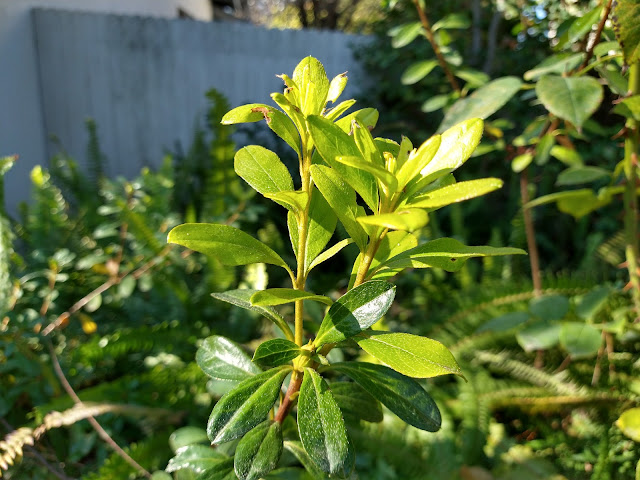
Waterlogged soil can lead to iron deficiency

|
| This azalea shows signs of chlorosis in its new growth. Waterlogged soil likely kept the plant from accessing iron in the soil. (Photos: Debbie Arrington) |
Are your azaleas looking a little peaked? It may not be a lack of nutrients, but too much water.
Cindy Nalepa-Nelson, an observant longtime gardener, noticed yellowish growth on azaleas in her Land Park garden. In a walk around her neighborhood, she spotted several other examples of azaleas that were showing telltale signs of chlorosis, or yellowing of normally green leaves.
Usually, this yellowing is a sign of iron deficiency. But that doesn’t mean there’s not enough iron in the soil. Due to soil conditions, the plant’s roots couldn’t access that iron when the bush needed it for green, chlorophyll-packed leaves.
Cindy wondered if the yellow leaves could be linked to recent rain, particularly December’s deluge. According to UC Cooperative Extension master gardeners, the heavy rain likely did play a role. But it didn’t leach out the iron; it waterlogged the soil.
“Azaleas, citrus, gardenias, rhododendrons, and other plants that are adapted to acidic soil are especially prone to iron deficiency when soil pH is above about 7.5 (alkaline),” say the master gardeners. “Iron deficiency is also common when soils are cool, high in calcium, poorly drained, or waterlogged.”

|
|
Here's another azalea with chlorosis. Notice the green veins
in the yellowish leaves.
|
Iron deficiencies tend to be more common in clay soils; the iron becomes “locked” in the soil and unavailable for plant roots.
Other signs of iron deficiency: Stunted or malformed new growth; mottled yellow leaves with green veins; and bud or fruit drop. Leaves may develop brown margins, too.
Because azaleas are shooting out new growth now, those yellowish leaves are more noticeable.
To remedy the problem, aerate the soil. Poke holes to encourage drainage. Add compost or other organic matter to help drainage as well as the soil’s acidity.
Then go ahead and feed those yellowish azaleas with chelated iron, a form of this nutrient that’s easily and quickly absorbed by plants – even in clay soils. Chelated iron is available at nurseries and home centers.
For more about iron deficiency in plants, check out these UC integrated pest management plant notes: http://ipm.ucanr.edu/PMG/GARDEN/PLANTS/DISORDERS/irondeficiency.html.
Comments
0 comments have been posted.Sacramento Digs Gardening to your inbox.
Sites We Like
Garden Checklist for week of May 5
Survey your garden after the May 4 rainstorm. Heavy rain and gusty winds can break the neck of large flowers such as roses. Also:
* Keep an eye on new transplants or seedlings; they could take a pounding from the rain.
* Watch out for powdery mildew. Warmth following moist conditions can cause this fungal disease to “bloom,” too. If you see a leaf that looks like it’s dusted with powdered sugar, snip it off.
* After the storm, start setting out tomato transplants, but wait on the peppers and eggplants (they want warmer nights). Pinch off any flowers on new transplants to make them concentrate on establishing roots instead of setting premature fruit.
* Trim dead flowers but not leaves from spring-flowering bulbs such as daffodils and tulips. Those leaves gather energy to create next year's flowers. Also, give the bulbs a fertilizer boost after bloom.
* Pinch chrysanthemums back to 12 inches for fall flowers. Cut old stems to the ground.
* Mulch around plants to conserve moisture and control weeds.
* From seed, plant beans, beets, cantaloupes, carrots, corn, cucumbers, melons, pumpkins, radishes and squash.
* Plant onion sets.
* In the flower garden, plant seeds for asters, cosmos, celosia, marigolds, salvia, sunflowers and zinnias. Transplant petunias, zinnias, geraniums and other summer bloomers.
* Plant perennials and dahlia tubers for summer bloom.
* Don’t wait; plant summer bulbs, such as gladiolus and tuberous begonias.
* Harvest cabbage, lettuce, peas and green onions.